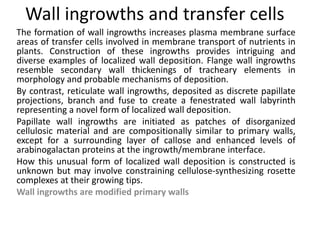Wall ingrowths and transfer cells
•Als PPTX, PDF herunterladen•
2 gefällt mir•4,698 views
Anatomy of angiosperms: Wall ingrowths and transfer cells
Melden
Teilen
Melden
Teilen

Empfohlen
Empfohlen
Weitere ähnliche Inhalte
Was ist angesagt?
Was ist angesagt? (20)
Ähnlich wie Wall ingrowths and transfer cells
Ähnlich wie Wall ingrowths and transfer cells (20)
Mehr von Dr. Harwinder Kaur
Mehr von Dr. Harwinder Kaur (20)
Kürzlich hochgeladen
This presentation was provided by William Mattingly of the Smithsonian Institution, during the fourth segment of the NISO training series "AI & Prompt Design." Session Four: Structured Data and Assistants, was held on April 25, 2024.Mattingly "AI & Prompt Design: Structured Data, Assistants, & RAG"

Mattingly "AI & Prompt Design: Structured Data, Assistants, & RAG"National Information Standards Organization (NISO)
Kürzlich hochgeladen (20)
Mixin Classes in Odoo 17 How to Extend Models Using Mixin Classes

Mixin Classes in Odoo 17 How to Extend Models Using Mixin Classes
Mattingly "AI & Prompt Design: Structured Data, Assistants, & RAG"

Mattingly "AI & Prompt Design: Structured Data, Assistants, & RAG"
Unit-IV; Professional Sales Representative (PSR).pptx

Unit-IV; Professional Sales Representative (PSR).pptx
Web & Social Media Analytics Previous Year Question Paper.pdf

Web & Social Media Analytics Previous Year Question Paper.pdf
Seal of Good Local Governance (SGLG) 2024Final.pptx

Seal of Good Local Governance (SGLG) 2024Final.pptx
Unit-V; Pricing (Pharma Marketing Management).pptx

Unit-V; Pricing (Pharma Marketing Management).pptx
This PowerPoint helps students to consider the concept of infinity.

This PowerPoint helps students to consider the concept of infinity.
Measures of Central Tendency: Mean, Median and Mode

Measures of Central Tendency: Mean, Median and Mode
SECOND SEMESTER TOPIC COVERAGE SY 2023-2024 Trends, Networks, and Critical Th...

SECOND SEMESTER TOPIC COVERAGE SY 2023-2024 Trends, Networks, and Critical Th...
Wall ingrowths and transfer cells
- 1. Wall ingrowths and transfer cells The formation of wall ingrowths increases plasma membrane surface areas of transfer cells involved in membrane transport of nutrients in plants. Construction of these ingrowths provides intriguing and diverse examples of localized wall deposition. Flange wall ingrowths resemble secondary wall thickenings of tracheary elements in morphology and probable mechanisms of deposition. By contrast, reticulate wall ingrowths, deposited as discrete papillate projections, branch and fuse to create a fenestrated wall labyrinth representing a novel form of localized wall deposition. Papillate wall ingrowths are initiated as patches of disorganized cellulosic material and are compositionally similar to primary walls, except for a surrounding layer of callose and enhanced levels of arabinogalactan proteins at the ingrowth/membrane interface. How this unusual form of localized wall deposition is constructed is unknown but may involve constraining cellulose-synthesizing rosette complexes at their growing tips. Wall ingrowths are modified primary walls
- 2. • Transfer Cells (Fig. 2.1): • These are specialized parenchyma cells characterized by wall ingrowths. The ingrowths are formed by the deposition of wall materials on the inner side of primary wall. The plasma membrane of the cell gets invaginated along with the outline of wall ingrowths and thus the surface area of plasma membrane is increased by many folds. • These cells are concerned with absorption and secretion where the invaginated plasma membrane facilitates the process. They occur in association with xylem and phloem, glandular hair, hydathodes, nectaries, salt glands, synergids etc.
- 3. • Transfer cells are plant cells with secondary wall ingrowths. These cells are ubiquitous, occurring in all plant taxonomic groups and in algae and fungi. Transfer cells form from differentiated cells across developmental windows and in response to stress. • They are considered to play a central role in nutrient distribution by facilitating high rates of transport at bottlenecks for apo-/symplasmic solute exchange. • These properties are conferred by their unique structural features—an invaginated secondary wall ensheathed by an amplified area of plasma membrane enriched in a suite of solute transporters. • Phloem parenchyma cells, called transfer cells and border parenchyma cells, are located near the finest branches and terminations of sieve tubes in leaf veinlets, where they also function in the transport of foods.
- 4. • A study of the fine structure of minor veins of mature leaves of 975 species and 242 families of Angiosperms shows that transfer cells are widespread amongst herbaceous Dicotyledons, are much rarer in woody Dicotyledons, and are virtually absent from the Monocotyledons.
- 5. • Four types of transfer cell are recognized in minor veins, all possessing irregular ingrowths of wall material protruding into their protoplasts, and all being regarded as modified parenchyma of the minor vein. • Two types occur in phloem. One (the A-cell), with ingrowths distributed right round its periphery, is associated specifically with the sieve elements. • The other (the B-cell) occurs more generally throughout the phloem and has zones of wall ingrowths oriented towards sieve elements and their associated companion cells or A-cells. • Two other types (C- and D-cells) occur in xylem parenchyma and bundle sheath respectively, and have ingrowths only on walls in contact with or in close proximity to vessels or tracheids. Each species has a characteristic combination of types of transfer cell.